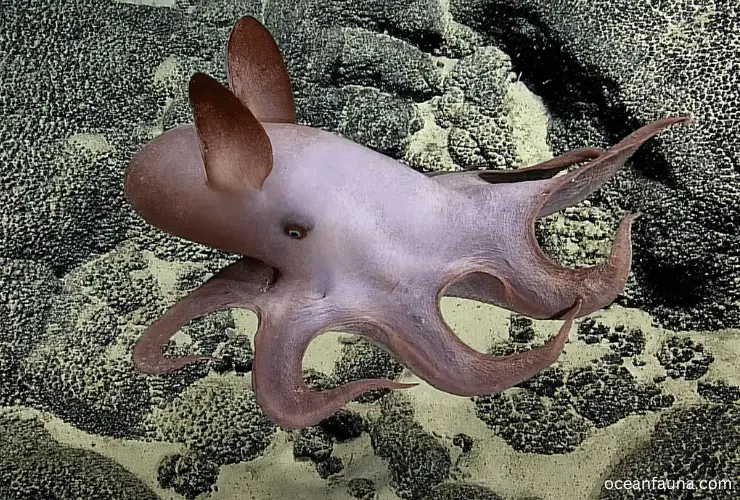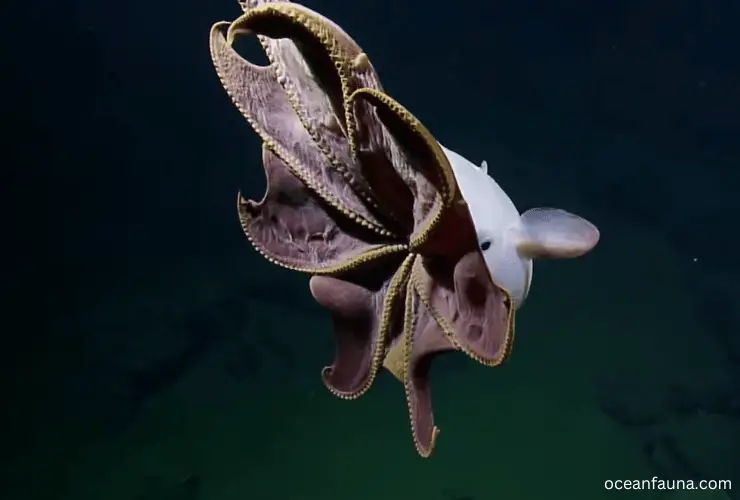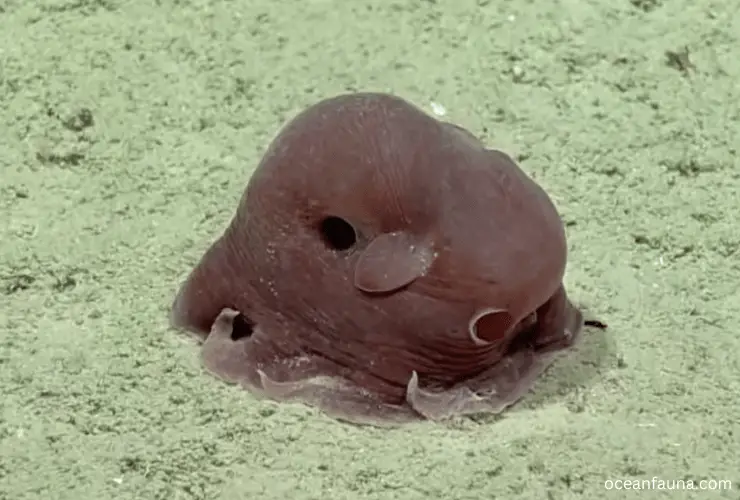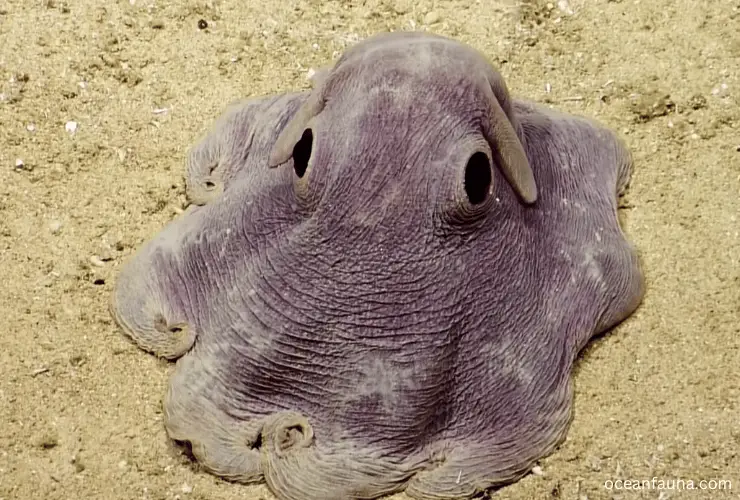Dumbo octopus species are found in oceans all over the world, usually at depths of 3,000 to 4,000 meters. They have large ear-like fins that give them their name and resemble those of Disney’s famous cartoon character Dumbo.
There are so many other fun facts about these unusual-looking creatures. In this article, I will try to discuss the top 10 dumbo octopus fun facts.
Fact 1. Dumbo Octopus’s Name
Dumbo octopus derives its name from the famous Disney character Dumbo the elephant, whose distinguishing feature was his oversized ears that acted like fins.
Similarly, the Dumbo octopus has ear-like fins, which are actually its webbed arms that it flaps to propel itself through the water. These fins resemble the large ears of the beloved elephant character, leading to the name “Dumbo” being used to describe this enchanting creature.

The scientific name of the Dumbo octopus is Grimpoteuthis, which means “gnarled octopus,” referring to its creased appearance and flexible body. However, the Dumbo octopus’s popularity has led to it being more commonly referred to by its quirky nickname.
Apart from that, The “umbrella octopus” is a group of Dumbo octopuses that can float with an umbrella-like appearance. There are roughly 17 known species of Dumbo octopuses in this group.
Fact 2. No Ink Sac
The Dumbo octopus is different from most octopuses because it hardly faces predators in the deep sea, which is why it doesn’t possess an ink sac.
Most octopuses use an ink sac to release a cloud of black ink when threatened, using it as a smokescreen to give them time to escape from predators. The Dumbo octopus does not need such protection because its home is so deep underwater.
Therefore, it does not possess an ink sac like some of its relatives in shallower waters.
Fact 3. Deepest-Living Octopus
The Dumbo octopus, the deepest-living octopus genus on Earth, can live at least 4000 meters (13,100 feet) below the surface. They can survive at such depths due to their unique adaptations that allow them to withstand intense pressure and lack of light.
For example, they have an ear-like patch on each side of their head that helps them sense light and sound waves. This enables them to hunt for food, even in pitch-black conditions.
Fact 4. Big Eye but Poor Vision
The Dumbo octopus has large eyes that are approximately one-third the width of its head, giving it a cartoonish appearance. Despite this, its eyesight is not very sharp because it lives in a dark environment and relies primarily on its sense of touch to navigate.
Moreover, its eyes are mainly used for sensing light coming from above. This allows them to differentiate between the pitch-black water and any faint glimmers of light that may be present.
Fact 5. Blue Blood
Human blood appears red when exposed to open air due to its iron content, whereas the blood of Dumbo octopuses appears blue because it contains a higher amount of copper. This copper content is more effective at circulating oxygen through the body in cold temperatures.
Also, this is an adaptation to the cold and deep waters they inhabit, as copper is better at maintaining their blood’s ability to carry oxygen in these extreme conditions.

Moreover, their blue blood also helps them to hunt in the dark, as it absorbs more of the small amounts of light found thousands of meters below the surface.
Fact 6. Swallow Prey in One Gulp
Dumbo octopuses search for small invertebrates to eat, pouncing on them and eating them whole once they have found them. They can also swallow their prey in one gulp.
They feed on a variety of food sources, such as worms, crabs, and clams. They have even been known to consume small fish if they are unable to find any other food source.
Fact 7. No Breeding Season
Dumbo octopuses engage in reproduction by males transferring sperm to females. The females then use the sperm to fertilize eggs that they have laid on either rocks or shells.
Research has revealed that females fertilize eggs at various times throughout the year, suggesting that there isn’t a particular season when they are more sexually active.
Also, females are known to lay up to 200,000 eggs at once. They then guard them until they hatch, which can take anywhere from three to four months.
Fact 8. Live Only in Ocean
Dumbo octopuses live in the very deep parts of the ocean, where the depth is at least 4000 meters. The water pressure in this zone is huge, and the water temperature is very cold. Because of this, they cannot survive outside of the ocean and will die if removed from it.

They also cannot survive in aquariums due to the artificial environment created there. In such an environment, the water pressure is too low, and the temperature is too high for them to survive.
Fact 9. Largest Dumbo Octopus
The largest Dumbo octopus ever recorded is a colossal creature that measures an impressive 5 feet 10 inches (1.8 m) in length and weighs a considerable 13 pounds (5.9 kg). This mammoth species, undoubtedly a marvel of nature, is a spectacle to behold.
In general, however, Dumbo octopuses are much smaller, with the average length ranging from 7.9 to 12 inches (20-30 cm). Despite this, they are no less fascinating, possessing unique features that set them apart from other octopus species.
Fact 10. Discovery of a New Species of Dumbo Octopus
The year 2016 marked a significant event in the field of marine biology with the discovery of a new species of dumbo octopus. This unique octopus species, was nicknamed the “Emperor Dumbo.”
It was found to be distinct from all known dumbo octopus species by employing advanced imaging techniques such as magnetic resonance imaging (MRI) and micro-computer tomography (micro-CT) scans.
Compared to other dumbo octopus species, the Emperor Dumbo boasts distinguishing features such as distinctive fin shapes and a unique arrangement of chromatophores on its tentacles. These traits were revealed through extensive analysis of the images generated by the advanced imaging techniques employed during the discovery.
FAQs
How many hearts does a dumbo octopus have?
The Dumbo octopus, similar to other octopuses, has three hearts. One heart is responsible for pumping blood throughout the body, while the other two hearts specifically pump blood to the gills. This unique cardiac design is likely due to the distinctive composition of the Dumbo octopus’s blood.
Want to know more? Dumbo octopuses possess blue blood due to high levels of hemocyanin, a copper-containing protein that is responsible for transporting oxygen throughout the body.
Unlike humans, who have red blood due to hemoglobin, the Dumbo octopus’s circulatory system operates differently, with the gills serving as the primary site of gas exchange.
Furthermore, Dumbo octopuses have been observed exhibiting a phenomenon known as bradycardia, where their heart rates slow to conserve oxygen during periods of low activity or stress. This adaptation allows the Dumbo octopus to survive in its deep-sea habitat, where oxygen levels are often limited.
Can dumbo octopus change color?
Yes, the Dumbo octopus, like other octopuses, can change its color. This is achieved through the use of specialized cells called chromatophores, which are distributed throughout the animal’s skin.
When the octopus wants to change color, it contracts or relaxes these cells to expose or hide different pigments, thereby altering its overall appearance.
The colors that a Dumbo octopus can change to include red, white, pink, or brown, depending on the situation they find themselves in.
For example, if they want to blend in with the surrounding water, they may change to a transparent or semi-transparent shade to become invisible.
Alternatively, if they want to mimic the appearance of a toxic or venomous animal, they may change their color to a bright, warning red.
How deep do dumbo octopus live?
The Dumbo octopus, a fascinating deep-sea creature, is known to live at great depths. It is typically found dwelling on the seafloor or hovering just above it, at depths ranging from 3000 to 4000 meters, which is an impressive 9800 to 13000 feet below the ocean’s surface.
This organism is specifically adapted to life in the deep sea, where it must navigate in near-total darkness, withstand immense water pressure, and search for prey in a largely unexplored environment.
Can dumbo octopuses move by jet propulsion?
Unlike many other octopus species, dumbo octopuses do not use jet propulsion to move. Instead, they have large fins on the top of their bodies and shorter arms on the sides, allowing them to move around in their underwater habitats.
Research shows that when dumbo octopuses move, they undulate their fins and arms in a rhythmic motion, which propels them forward. This movement allows them to navigate the water precisely and steer themselves in any direction.
Dumbo octopuses are known to be skillful swimmers, capable of controlling their movements with great agility.
Conclusion
Dumbo octopuses are fascinating creatures inhabiting the oceans’ deep and cold parts. They have adapted to their environment by developing features such as blue blood, webbed fins, and a higher copper content in their blood.
They also hunt for small invertebrates like worms, crabs, clams, and even small fish, which they consume in one gulp. If you want to know more about them, let me know.


1 thought on “The Top 10 Dumbo Octopus Fun Facts”